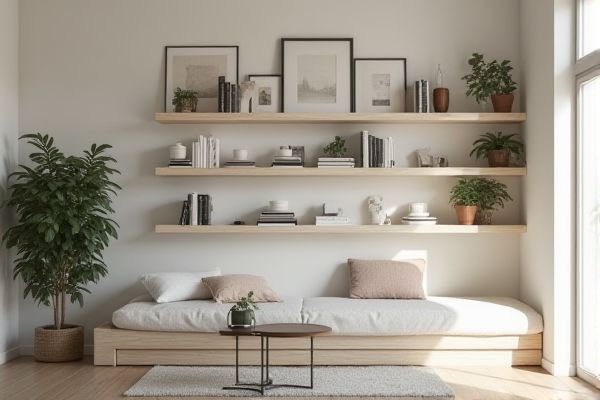
Corner shelves maximize unused space by fitting snugly into room corners, ideal for small areas or displaying decorative items, while straight shelves offer versatile, linear storage suitable for larger walls and heavier items. Discover which shelving option best suits your space and style by reading the full article.
Table of Comparison
| Feature | Corner Shelves | Straight Shelves |
|---|---|---|
| Space Utilization | Maximizes unused corner space | Utilizes straight wall space effectively |
| Design Aesthetic | Creates unique, compact look | Offers traditional and clean appearance |
| Storage Capacity | Limited by corner dimensions | Generally larger and more versatile |
| Installation | Requires precise corner fitting | Simpler, straightforward mounting |
| Accessibility | May be harder to access items in the corner | Easy to reach items along straight line |
| Common Uses | Storage in small rooms, kitchens, bathrooms | Books, decor, media, general storage |
Introduction to Corner Shelves vs Straight Shelves
Corner shelves maximize unused space by fitting into room angles, offering efficient storage solutions ideal for small areas or awkward corners. Straight shelves provide a classic, versatile storage option with easy installation and a clean, linear aesthetic suitable for various wall spaces. Choosing between corner shelves and straight shelves depends on your room layout and storage needs to enhance both functionality and design.
Space Utilization: Maximizing Your Room
Corner shelves capitalize on underutilized room angles, making them ideal for maximizing space in small or awkwardly shaped rooms. Straight shelves offer versatile placement along walls, providing continuous storage without interrupting flow but may leave corners unused. Choosing between the two depends on the room's layout and specific storage needs to optimize overall space utilization.
Aesthetic Appeal: Style Differences
Corner shelves enhance your space by adding a unique, angular aesthetic that breaks the monotony of straight lines, creating visual interest and maximizing room corners. Straight shelves offer a classic, streamlined style that complements minimalist and modern interiors with clean, uninterrupted horizontal lines. Choosing between corner and straight shelves depends on your desired design impact and spatial functionality, balancing form and style effectively.
Installation and Setup Ease
Corner shelves typically require more precise measurements and alignment due to their angled design, making installation slightly more complex compared to straight shelves. Straight shelves offer straightforward mounting with simpler brackets and consistent wall support, which often results in quicker setup. Your choice depends on balancing the desire for space-saving corner aesthetics with the ease of installation.
Storage Capacity Comparison
Corner shelves maximize storage capacity by utilizing otherwise wasted corner space, making them ideal for small rooms and tight areas. Straight shelves offer more straightforward access and better suit linear wall space, but often leave corners underutilized. Overall, corner shelves provide increased volume efficiency by fitting into niche spaces, while straight shelves excel in accessibility and display flexibility.
Ideal Rooms and Placement
Corner shelves maximize space efficiency in small rooms such as bathrooms, kitchens, and living rooms by utilizing often underused corner areas, making them ideal for compact spaces or tight corners. Straight shelves work well in larger rooms like home offices, bedrooms, or hallways where wall space is ample, providing easy access and display for books, decor, or storage bins. Strategic placement of corner shelves near seating areas or entryways enhances functionality, while straight shelves positioned at eye level optimize visibility and accessibility.
Cost and Budget Considerations
Corner shelves often provide a cost-effective storage solution by maximizing unused space, reducing the need for additional shelving units, and typically costing less per linear foot compared to straight shelves. Straight shelves usually require more wall space and may involve higher installation costs, especially if custom sizing or multiple units are needed to match the capacity of a corner shelf. Evaluating your budget should factor in material quality, installation complexity, and the amount of usable storage to ensure you get the best value for your investment.
Durability and Material Choices
Corner shelves are typically designed to maximize space and often use sturdy materials like solid wood or metal, offering enhanced durability due to their structural support from two walls. Straight shelves come in a wider variety of materials, including MDF, glass, and plastic, which can vary significantly in strength and lifespan. Choosing the right material for your shelves depends on durability needs and aesthetic preferences, ensuring your storage solution remains stable and long-lasting.
Customization and Versatility
Corner shelves offer superior customization by fitting into unused angular spaces, maximizing room functionality and creating unique storage solutions tailored to specific dimensions. Straight shelves provide greater versatility with standardized sizes that accommodate a wide range of items and easily integrate into various room layouts. Both shelf types can be customized with adjustable heights, materials, and finishes to match decor styles and storage needs effectively.
Pros and Cons: Corner Shelves vs Straight Shelves
Corner shelves maximize unused space by fitting into room corners, making them ideal for small areas and creating a unique visual appeal, but they may offer limited storage capacity and accessibility. Straight shelves provide straightforward installation, greater versatility for storing larger items, and easier access, yet they often consume more wall space and can disrupt room flow. Your choice depends on balancing space efficiency with storage needs and aesthetic preferences.
 homyna.com
homyna.com